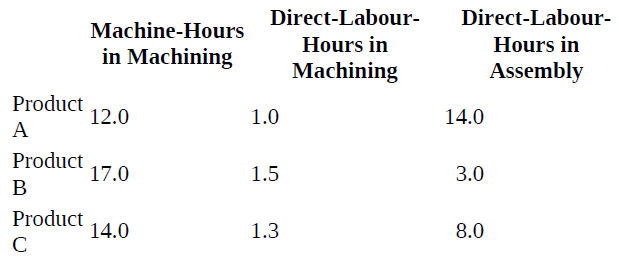The Tsang Manufacturing Company has two producing departments, machining and assembly. Mr. Tsang recently automated the machining
Question:
The Tsang Manufacturing Company has two producing departments, machining and assembly. Mr. Tsang recently automated the machining department. The installation of a computer-aided manufacturing (CAM) system, together with robotic workstations, drastically reduced the amount of direct labour required. Meanwhile, the assembly department remained labour intensive.
The company had always used one firm-wide rate based on directlabour- hours as the cost-allocation base for applying all costs (except direct materials) to the final products.
Mr. Tsang was considering two alternatives: (1) continue using direct labour- hours as the only cost-allocation base, but use different rates in machining and assembly, and (2) use machine-hours as the cost allocation base in the machining department while continuing with direct-labour-hours in assembly.
Budgeted data for 2010 are
1. Suppose Tsang continued to use one firm wide rate based on direct labour- hours to apply all manufacturing costs (except direct materials) to the final products. Compute the cost-application rate that would be used.
2. Suppose Tsang continued to use direct-labour-hours as the only cost-allocation base but used different rates in machining and assembly.
a. Compute the cost-application rate for machining.
b. Compute the cost-application rate for assembly.
3. Suppose Tsang changed the cost accounting system to use machine-hours as the cost-allocation base in machining and direct labour- hours in assembly.
a. Compute the cost-application rate for machining.
b. Compute the cost-application rate for assembly.
4. Three products use the following machine-hours and direct-labourhours.

a. Compute the manufacturing cost of each product (excluding direct materials) using one firmwide rate based on directlabour- hours.
b. Compute the manufacturing cost of each product (excluding direct materials) using direct-labour-hours as the costallocation base, but with different cost-allocation rates in machining and assembly.
3. Compute the manufacturing cost of each product (excluding direct materials) using a cost-allocation rate based on directlabour- hours in assembly and machine-hours in machining.
4. Compare and explain the results in requirements 4a, 4b, and 4c.
Step by Step Answer:

Management Accounting
ISBN: 978-0132570848
6th Canadian edition
Authors: Charles T. Horngren, Gary L. Sundem, William O. Stratton, Phillip Beaulieu





